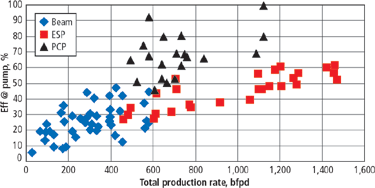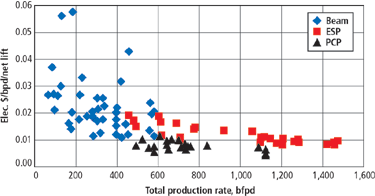|
| |
|

By Petroleum Technology Transfer Council |
Progressing cavity pumps: Insights from 14 years in a Southern Oklahoma waterflood
After experience with beam pumps and electric submersibles, the operator found progressing cavity pumps to be more cost effective and efficient in its 2,100-ft deep waterflood operation
Ken Oglesby, Oak Resources, Inc., Tulsa, Oklahoma, and Gary Scheer, Advanced Rotary Pump Systems, Inc., Chickasha, Oklahoma
Oak Resources, Inc. (Oak) began employing progressing cavity pumps (PCPs) in the West Hewitt Penn Sand Unit, a waterflood in Southern Oklahoma, in September 1988. Unit wells produce 200 bfpd to 1,400 bfpd from about 2,100 ft. Initial PCP installation costs were found to be 25% below those of beam-pump units and electrical submersible pumps (ESPs). Electrical power savings are 5% below beam-pumped units and 35% below ESPs, for comparable production rates. Through an evolution of PCP configurations and designs, up to a seven-year stator life is now expected, with only minor repairs. Adjustable rates at the surface, low capital costs, low repair costs and high electrical efficiency make PCPs attractive in this type application.
WEST HEWITT PENNSYLVANIAN UNIT, PCP BACKGROUND
The 2,100-ft deep field was discovered in 1939, and was mostly developed within six months. Waterflooding began in 1968, with operations at a field water-oil ratio of 80. Unit production now averages about 4 bopd per well (range of 1 – 8 bopd), and 320 bwpd (range of 50 – 1,200 bwpd). Oil gravity is 33.5° API, with only a mild paraffin tendency and a sulfur content of 0.65%. Produced water composition averages 130,000 ppm total dissolved solids, 6.0 pH, 30,000-ppm total hardness; and it exhibits some carbonate- and iron sulfide-scaling tendencies.
Due to the waterflood impact, by the early 1970s, some beam units were replaced with ESP units capable of rates exceeding 2,000 bfpd. Although ESP run lives were favorable, they were expensive to operate, expensive to pull, and rate adjustment with changing conditions was not easy or cheap. Oak bought the property in 1987, and began looking at other artificial lift methods to lower operating costs.
PCPs were attractive, with capacities that overlapped larger beam units and smaller ESPs, as well as having 25% lower initial costs. Oak began installing PCPs in September 1988, in wells producing 400 – 1,200 bfpd (barrels fluid per day), that also had at least 200-ft of dynamic fluid level over the pump. Produced fluids and field chemicals were sampled and tested for elastomer compatibility and pump design. PCPs have been used in 10 wells to date.
FIELD EXPERIENCE WITH PCP COMPONENTS
Major PCP components are: rotor, stator and drive head. Other well components are similar to other lift equipment, i.e., tubing, rods and motors.
Rotors are of a single, helical-configuration steel rod with a smooth surface. Current coating preference is double chrome coatings, although solid stainless steel rotors have been used. Rotor breakage has been minor; and, when it occurs, it is normally related to elastomer swelling or PCP design (rotor-stator fit). Using undersized rotors in stators after elastomer swelling had occurred was unsuccessful. Some earlier worn rotors were re-chromed; but this is not recommended due to: loss of the original rotor profile, remaining pitting and the resultant lower efficiency.
Stators were typically 3.5-in.-OD steel casing with an elastomer molded into it to form a double helical hole. The elastomer composition is critical to PCP success. A standard Buna-N, low-acrylonitrile (ACN) formulation was initially recommended by the manufacturers, based on compatibility screening tests using field oil; however, severe swelling problems still occurred. After various tests on possible causes, a new, higher ACN elastomer formulation was successfully tried; but, after much field-testing, only one manufacturer was able to provide a suitable, long-life elastomer composition.
Later, two multi-lobe (4 rotor-5 stator) PCP designs were field tested, since that design would provide a higher production rate at a lower rpm. However, high vibration due to design or elastomer swelling caused early termination of tests. It is recommended that, for new applications, elastomer compatibility tests using actual field oil and brine be conducted at reservoir temperature and pressure. Manufacturers should stand behind their elastomer recommendations based on these tests.
Stator runs are now approaching a seven-year life, from earlier run lives of about four years – if re-run stators/ test designs/ off-brand elastomer tests are eliminated.
Early drive heads were grease-lubricated, solid-shaft designs and were installed new. However, they were rebuilt many times, which eventually contributed to later shortened drive lives. Drive head lubrication and pumper maintenance training is critical. Newer drive heads that utilize oil-bath lubrication to provide for longer life and hollow shafts are now used. Sheaves and belts provide a simple, yet effective method for adjusting pump speed and, therefore, production rate.
Power bands require less tension with less slippage and are used on some installations. Pump-off controllers are not required, since 200 ft of fluid is maintained above the pump suction. Only 10- and 20-hp premium efficiency, low-slip (B), 1,200-rpm, TEFC electrical motors are used, even for lifting up to 1,200 bfpd.
Stuffing box/packing leaks, aggravated by sudden ambient temperature changes, were a continuing problem. Graphite-impregnated Teflon packing has reduced, but not completely eliminated, leaks. Drain tubes from the drive head cavity around the stuffing box back into the tubing-casing annulus help control minor leaks. Newer, but expensive, sealing sections are now available for these older drive heads. The newer drive heads now used have a hollow-rod design that allows easier pulling and minimizes leak potential.
Rods and tubing. New rods without centralizers were used in all installations. Most typical rod strings were 7/8-in. with one 1-in. rod below the drive head, and one above the rotor. Only one well with unusual rod wear was evident. Early rod parts were reduced by stator elastomer improvements (reduced torque and surging) and drive head alignment using flanged drive heads. Whenever a well was pulled, pony rods were alternated to move rod-tubing wear points. Used, tested J55 or N80 tubing has been used, without special anchors. Excessive tubing wear has not been a problem.
OPERATIONAL CONSIDERATIONS, PERFORMANCE RESULTS
Some PCPs had pressure/ rate surging problems on startups due to a too-tight stator-rotor fit because of elastomer swelling or solids buildup in the pump. Batch circulating a surfactant in the well often reduced or eliminated this problem. In all new installations, the surface equipment was ready to immediately put the well on pump as soon as the drive head was set. It is most important that PCPs not run dry, as this will cause elastomer overheating and rapid destruction. To prevent this problem, Oak targeted a 200-ft dynamic fluid above the pump; but no shut-off controllers are used.
In 1996, Oak and the University of Tulsa performed an in-depth comparative study of efficiencies and power consumption for beam-pump, ESP and PCP installations. Fig. 1 compares volumetric efficiencies, and shows that PCPs were 43% more volumetrically efficient than ESPs, and 169% more efficient than beam units. Fig. 2 compares lifting costs, and shows that on a power per barrel (kW/bbl) basis, PCPs were 35% more efficient than ESPs, and 5% more efficient than beam units. 
 |
Fig. 1. 1996 Comparative study of West Hewitt Penn Sand Unit volumetric efficiency at pump discharge.
|
|
 |
Fig. 2. 1996 Comparative study of West Hewitt lifting costs, electrical costs per barrel.
|
|
ACKNOWLEDGMENT
Content was abstracted from Paper SPE 80919, “Fourteen years of progressing cavity pumps in a Southern Oklahoma waterflood,” presented at the SPE Production Operations Symposium, Oklahoma City, Oklahoma, March 23 – 25, 2003.
THE AUTHORS
|
 |
Ken Oglesby, president of Oak Resources, Inc., has a BS in petroleum engineering and MS in general engineering from the University of Tulsa. Oak focuses on new technology to improve productivity and lower costs for oil and gas production and drilling operations.
|
 |
Gary Scheer, manager of sales for Advanced Rotary Pump Systems, Inc., is responsible for design/ installation of PCP equipment from a variety of manufacturers. He has over 20 years' experience with PCPs in the domestic US for oil, gas, coalbed methane and water wells.
|
| |
|
|






